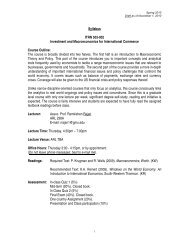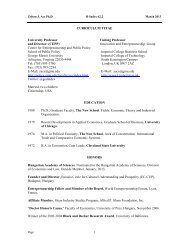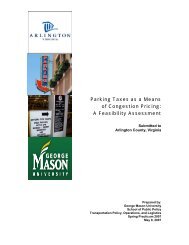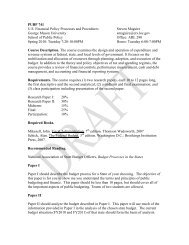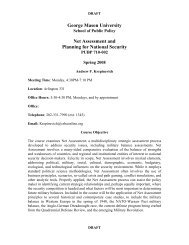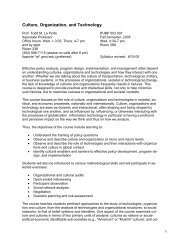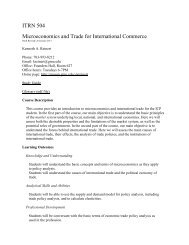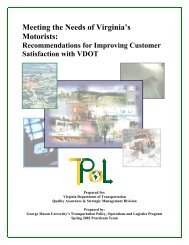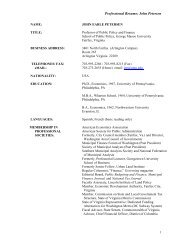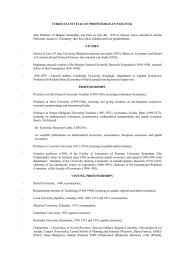Cost Benefit Analysis of Washington-Richmond High-Speed Rail
Cost Benefit Analysis of Washington-Richmond High-Speed Rail
Cost Benefit Analysis of Washington-Richmond High-Speed Rail
Create successful ePaper yourself
Turn your PDF publications into a flip-book with our unique Google optimized e-Paper software.
<strong>Cost</strong> <strong>Benefit</strong> <strong>Analysis</strong> <strong>of</strong> <strong>Washington</strong>-<strong>Richmond</strong> <strong>High</strong>-<strong>Speed</strong> <strong>Rail</strong> Spring 2010<br />
2. <strong>High</strong>-<strong>Speed</strong> <strong>Rail</strong> Policy<br />
The level <strong>of</strong> interest in HSR by members <strong>of</strong> Congress dates back at least to the mid 1960s. With the<br />
passage <strong>of</strong> the <strong>High</strong>-<strong>Speed</strong> Ground Transportation (HSGT) Act, this legislation, initially authorized at $90<br />
million, started an effort, at the Federal level, to develop, and demonstrate where possible,<br />
contemporary and advanced HSGT technologies. Under the HSGT Act, the Office <strong>of</strong> <strong>High</strong>-<strong>Speed</strong> Ground<br />
Transportation <strong>of</strong> the FRA introduced modern HSGT to America in 1969 by deploying the self-propelled<br />
Metroliner cars and the Turbotrain into what would soon become Northeast Corridor revenue service.<br />
Simultaneously, the construction <strong>of</strong> new suburban rail stations at Metropark (Iselin), New Jersey, and<br />
Capital Beltway (Lanham), Maryland significantly improved access to this new service. The service<br />
improvements, <strong>Washington</strong>—New York—Boston, represented a private/public partnership between the<br />
freight railroad companies, the equipment suppliers, States, localities, and the FRA. 4 The program also<br />
included a comprehensive multimodal transportation planning effort focusing on long-term needs in the<br />
Northeast Corridor “megalopolis,” 5 as well as a pioneering research and development program in such<br />
advanced technologies as tracked air-cushion vehicles, linear electric motors, and magnetic levitation<br />
(Maglev) systems.<br />
The <strong>Rail</strong> Passenger Service Act <strong>of</strong> 1970 led to the creation <strong>of</strong> the National <strong>Rail</strong>road Passenger<br />
Corporation (Amtrak) in 1971 as a way <strong>of</strong> ensuring continued operation <strong>of</strong> an intercity rail passenger<br />
network in the United States.<br />
On May 1, 1971, Amtrak took over the responsibility for operating intercity rail service from the freight<br />
railroads in most <strong>of</strong> the United States. This would also include the Northeast Corridor. As the result <strong>of</strong><br />
this take over, Amtrak initiated a number <strong>of</strong> research, planning, development, and demonstration<br />
efforts under the HSGT Act to recommend improved HSR in the Northeast Corridor as the optimal<br />
response to steadily increasing congestion and decreasing service in the other intercity modes. 6<br />
While the Metroliners and Turbotrain demonstrated the potential for HSR transportation, the Boston-<br />
<strong>Washington</strong> route infrastructure was still suffering from many years <strong>of</strong> neglected maintenance. Thus, in<br />
1975, the Congress shifted their focus to upgrading the Northeast Corridor infrastructure to improve the<br />
reliability <strong>of</strong> the service and allow for shorter trip times, particularly between New York City and<br />
<strong>Washington</strong>, D.C. Pursuant to Title VII <strong>of</strong> the <strong>Rail</strong>road Revitalization and Regulatory Reform Act <strong>of</strong> 1976,<br />
a total <strong>of</strong> $3.3 billion 7 was appropriated for the Northeast Corridor Improvement Project (NECIP). This<br />
project was a massive engineering and construction effort which was slated to improve major sections<br />
<strong>of</strong> the main line by means <strong>of</strong> track reconstruction, new signals and control systems, elimination <strong>of</strong> many<br />
highway/railroad grade crossings, construction <strong>of</strong> maintenance-<strong>of</strong>-way bases and maintenance-<strong>of</strong>-<br />
4 Walter Shapiro, “The Seven Secrets <strong>of</strong> the Metroliners Success,” The <strong>Washington</strong> Monthly, March 1973.<br />
5 So termed by Senator Claiborne Pell in his book Clairborne Pell, Megalopolis Unbound (Prager, 1966)<br />
6 Improved <strong>High</strong>-<strong>Speed</strong> <strong>Rail</strong> in the Northeast Corridor (U.S. Department <strong>of</strong> Transportation, 1973).<br />
7 Amtrak's Northeast Corridor: Information on the Status and <strong>Cost</strong> <strong>of</strong> Needed Improvements (General Accounting<br />
Office, April 13, 1995).<br />
10



